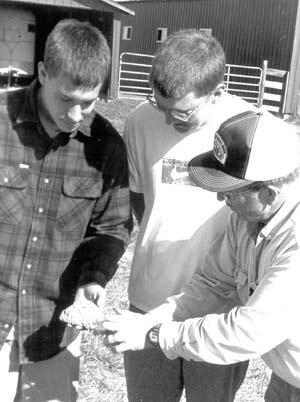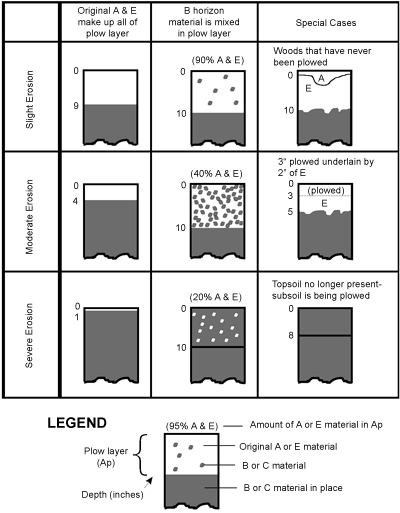II. SOIL AND LANDSCAPE PROPERTIES
Erosion Next Section>>
Soil erosion is the removal of soil by water, by wind, or both, caused largely by man’s intensive use of land. Soil erosion processes are described further in Chapters III and VI of this manual.

Fig 13. Coach Curt Campbell, Southwood High School, shows
mottles in a soil sample.

Fig 14. Sketches representing several examples of slight, moderate, and severe erosion.
Surface horizons almost always contain more organic matter than subsurface horizons. Soils with more organic matter have larger water and nutrient holding capacities and faster water absorption. When erosion carries away topsoil, it reduces the favorable soil properties associated with organic matter. Thus, erosion reduces agricultural productivity and makes it more difficult to grow lawns, gardens, and trees.
The degree of soil erosion is judged by the amount of original surface material remaining in the plow layer (Ap horizon) or in the upper 8 inches of soil if the Ap is less than 8 inches thick. The original surface material is the soil material that was originally in A or E horizons. It usually contains more organic matter, is darker (blacker), and contains less clay than the subsoil (B horizon).
Soil erosion classes are determined from the plow layer (Ap), or upper 8 inches if the Ap is less than 8 inches:
- None to slight: This layer contains more than 75% of original surface material.
- Moderate: This layer contains 25% to 75% of original surface material.
- Severe: This layer contains less than 25% of original surface material.
“Original surface material” means soil material that was once the A and E horizons (above B horizons). A soil that has never been plowed, such as in a woods, is considered to have slight erosion.
The three classes of soil erosion are illustrated in Fig. 14. In some cases the original surface material makes up all of the plow layer, and B or C horizon material is immediately below the plow layer. This is illustrated in the left column of the diagrams. In these cases one simply measures the thickness of the surface horizon to determine the degree of erosion. In the top sketch, the Ap is more than 8 inches thick and all of it consists of original surface material, so the soil has slight erosion. In the middle sketch, 4 inches, or 50% of the upper 8 inches, consists of original surface material so the soil is moderately eroded, and in the lower one, only 12% is original surface material.
In other cases, illustrated in the center column, B horizon material is mixed in the plow layer. The B horizon material usually contains more clay and is redder or browner in color than the surface material. It often resembles the soil material in the horizon below the plow layer. In these cases, the percentage of original surface material remaining must be estimated. In the “slight” example, 90% of the plow layer is original surface material. In the “moderate” example there is 40%, and in the “severe” example there is only 20% of original surface material left. In some places in Indiana, erosion is so severe that the C horizon is mixed in the plow layer.
Some special cases are illustrated in the right column of diagrams. A soil that has never been plowed, such as one in the woods, is illustrated under “slight erosion.” This soil has a darker colored A horizon over a lighter-colored E horizon, but it is not eroded. Both A and E horizon materials are considered to be surface material. The E horizon usually has less clay and is not as red or brown as the horizon below it. In the “moderate” example there are 3 inches of plow layer plus two inches of in-place E horizon for a total of 5 inches of original surface material which constitutes 5/8 or 62% of the upper 8 inches of soil. Other soils are so severely eroded (bottom right) that only subsoil is being plowed. Such soils are “severely eroded.”
